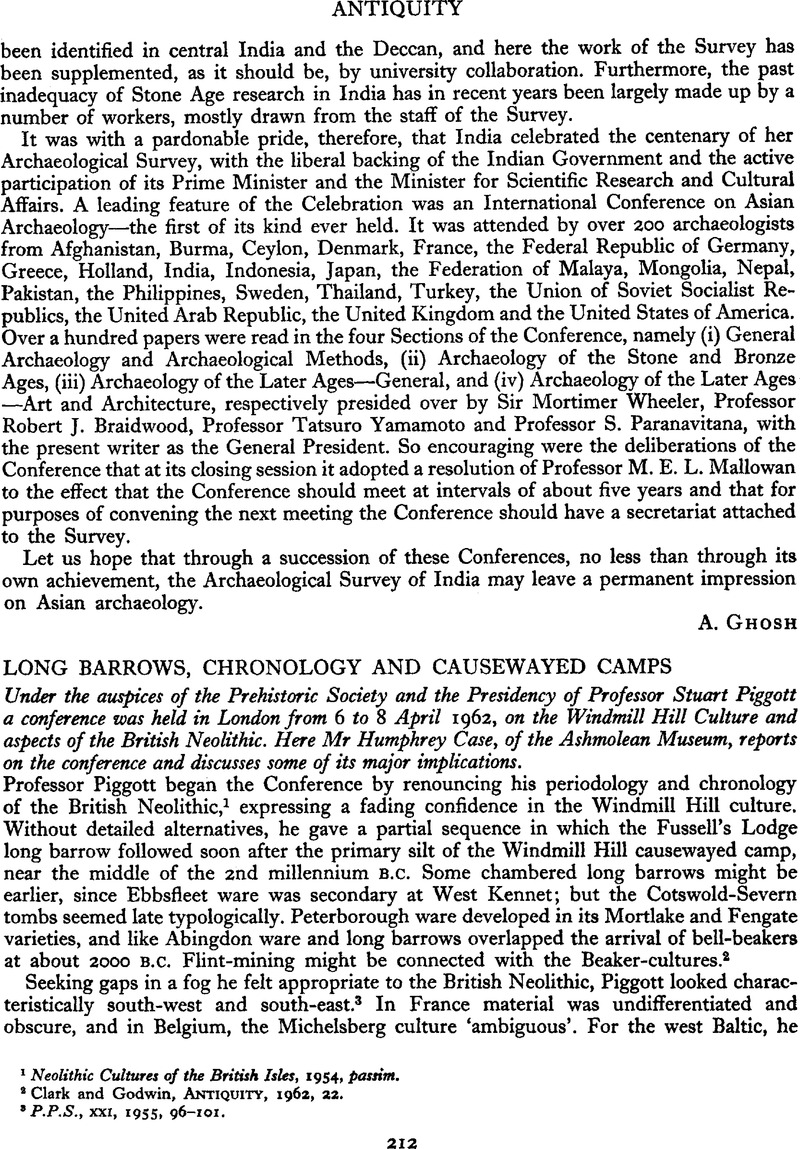No CrossRef data available.
Published online by Cambridge University Press: 02 January 2015

1 Neolithic Cultures of the British Isles, 1954, passim.
2 Clark and Godwin, ANTIQUITY, 1962, 22.
3 P.P.S., XXI, 1955, 96–101.
4 Becker, Aarbeger, 1947, 185 ff.
5 Ibid., 249 ff.
6 Jażdżewski, Prace . . . Muz. Arch . . . w. Lodzi, Seria Arch., VI, 1961, 85.
7 In Thorvildsen’s gazetteer of dolmen-period graves, long barrows are three times more numerous than round (Aarbeger, 1941, 77 ff.).
8 Salten, Jutland (loc. cit.); Buinen, Drenthe (Analyses: Junghans et al., Studien . . . der Metallurgie, 1, 1960, nos. 836–837). Arupgârd, Jutland (Sylvest and Sylvest, Kuml, 1960, 9 ff.) may be early MN like the Bygholm hoard (Otto and Witter, Handbuch . . ., 1952, e.g. no. 361) found nearby.
9 Becker, ANTIQUITY, 1959, 90.
10 Case, U.J.A., XXV, in press.
11 A westerly derivation as in Case, Ant. J., XXXVI, 1956, 29, now seems harder to justify (U.J.A., XXV, in press).
12 E.g. Jażdżwski, loc. cit., passim.
13 Florin, Vrâkulturen, 1958, 168–169.
14 Dumitrescu, Dacia, N.S. 1, 1957, 73–96.
15 Cp. Mellaart, ANTIQUITY, 1960, 273; Piggott, Id., 293. An axehead probably of smelted copper (Otto and Witter, loc. cit., no. 99) came from Thayngen-Weier, a Michelsberg site dated by Müller-Beck (Germania, XXXIX, 1961, 430) within range 3095–2875 B.C.—apparently assuming that the Egyptian 3rd dynasty is dated astronomically.
16 Clark, ANTIQUITY, 1962, 22.
17 Glob, Aarbøger, 1944, 207; Becker, Acta Arch., XXV, 1954, 134.
18 Waterbolk, Palaeohistoria, VIII, 1960, 83, 89; ANTIQUITY, 1960, 16–18.
19 One unpublished date from the cult-house at Tustrup, east Jutland (Kuml, 1955, 7–35), yielding early MN material, appears to confirm this estimation.
20 Palaeohistoria, IV, 1955, 47–79.
21 This would involve estimating the start of the Irish late Neolithic at 3500 B.C. at the latest (Case, P.P.S., xxvii, 1961, 213, 221), but the dates of the Mound of the Hostages and Four Knocks II are so late that they cannot even be plotted here on FIG. I.
22 Mr P. Ashbee, the excavator, showed the conference an illustration.
23 Cp. Kohler and Ralph, A.J.A., LXV, 1961, 357–368.
24 In discussion Professor R. de Valéra recommended treating all long barrows, chambered or unchambered, as a single cultural trait following Crawford and Keiller, Wessex from the Air, 1928, 11.
25 Coursaget et al., ANTIQUITY, 1962, 140.
26 As in Neolithic Cultures, 28 ff.
27 Partially published in Excavations at Dorchester, 1951, 60–63; ANTIQUITY, 1955, 4–9.
28 ANTIQUITY, 1958, 106–111.
29 ANTIQUITY, 1960, 297–298.
30 British Barrows, 1877, 506.